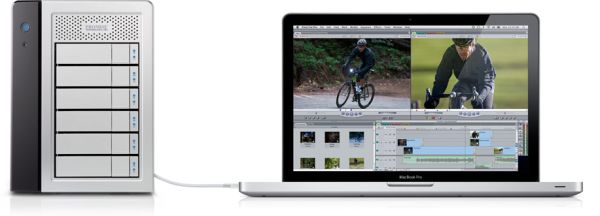MacBook Pro 2011 Refresh: Specs and Details
by Andrew Cunningham on February 24, 2011 4:40 PM ESTThunderbolt
The new MacBook Pros offer the array of ports we're used to, plus something a bit different.
A new port called Thunderbolt replaces the Mini DisplayPort found in earlier models. Formerly codenamed Light Peak, the new Intel standard promises up to 10 Gbps bi-directional data transfer speeds and connectivity for an array of devices, from displays to hard drives. The standard also supports 8-channel audio, which should make for easy connection to HDMI devices with the right adapter, and up to six different Thunderbolt devices can be daisy chained together according to the Intel specs.
Most of the given use scenarios for Thunderbolt focus on external hard drives, displays, and HD video hardware, and adapters for existing standards like eSATA and Firewire. If Thunderbolt ports become more widespread, we'll probably see additional applications of the standard.

Finally, it's worth noting that if you've already spent money on Mini DisplayPort adapters, dongles and cables for your existing Mac, those accessories will continue to work with the new Thunderbolt port.
Look for more from us on Thunderbolt shortly.
Conclusions
Thunderbolt aside, there's not much that surprises about the new MacBook Pro lineup - as usual, new, faster hardware is being sold to us in the same attractive unibody case to which we've become accustomed.
Most of the additions are welcome, though the value proposition continues to be a struggle. As usual, to save money, you're better off buying the base model and adding RAM or a new hard drive yourself than paying Apple's price for upgrades.
The move to Sandy Bridge is interesting but the lack of any mention of Quick Sync is a bit bothersome. We’re working on our review of the new platforms, expect to see results in the coming days.











128 Comments
View All Comments
pukemon - Friday, February 25, 2011 - link
I think a more legitimate gripe is: wouldn't it have made sense for Apple to just use the same panel from the 13" Macbook Air (which is 1440x900) instead of using the same screen they've been using for the last two years? That would be one less part they'd need to carry.robco - Thursday, February 24, 2011 - link
I find it odd that the base 15" still ships with a 256MB card in this day and age. You need 512 to run a large external display well. Not only that, but the integrated graphics have 384MB available, it will actually have more video memory running under the IGP than it does when it switches to the dedicated card. This lowballing by Apple is puzzling. As much as I love my current MBP, I couldn't justify the high cost again. Apple makes some nice gear, but if all you want is the larger display and dedicated graphics, it's just not worth the price premium.dagamer34 - Thursday, February 24, 2011 - link
IGP does not use VRAM as it is directly connected to the dedicated GPU. It isn't shared with the rest of the system.robco - Thursday, February 24, 2011 - link
Someone needs to explain this to Apple. On the specs page, they list the Intel IGP as sharing 384MB with the system. In any case, I find it frustrating that Apple wouldn't at least spring for 512. You can barely find even a low-end card that ships with less, much less an $1800 laptop.Surkov - Thursday, February 24, 2011 - link
If these MacBook Pros are running on the 6gbps ports, should I be able to throw a Vertex 3 in there and enjoy the fullest potential of its throughput?Also, I know there's no TRIM in OSX
johnspierce - Saturday, February 26, 2011 - link
Apple has announced OSX Lion 10.7 will have TRIM. It's about time!jamesst - Thursday, February 24, 2011 - link
It looks like Apple does indirectly mention Sandy Bridge's QuickSync capabilities. Under the details page for the processor they say the following (on Apple's MacBook Pro web page):"An integrated video encoder enables HD video calls with FaceTime, while an efficient decoder gives you long battery life when you’re watching DVDs or iTunes movies."
That sounds like QuickSync to me.
dagamer34 - Friday, February 25, 2011 - link
QuickSync is an encoder, not a decoder. Intel's GPU's have had hardware H.264 decoding for quite some time.jamesst - Monday, February 28, 2011 - link
No, sorry, you're completely wrong. Quick Sync is both an encoder and decoder. In fact, transcoding is one of the primary features of Quick Sync, it speeds up both the decoding and encoding.Heathmoor - Thursday, February 24, 2011 - link
How can Thunderbolt/Light/Peak support HDMI and DisplayPort if their max bandwidth of these other interfaces can exceed 10 Gb/s?Can the move from Mini DisplayPort to Thunderbolt compromise video performance?